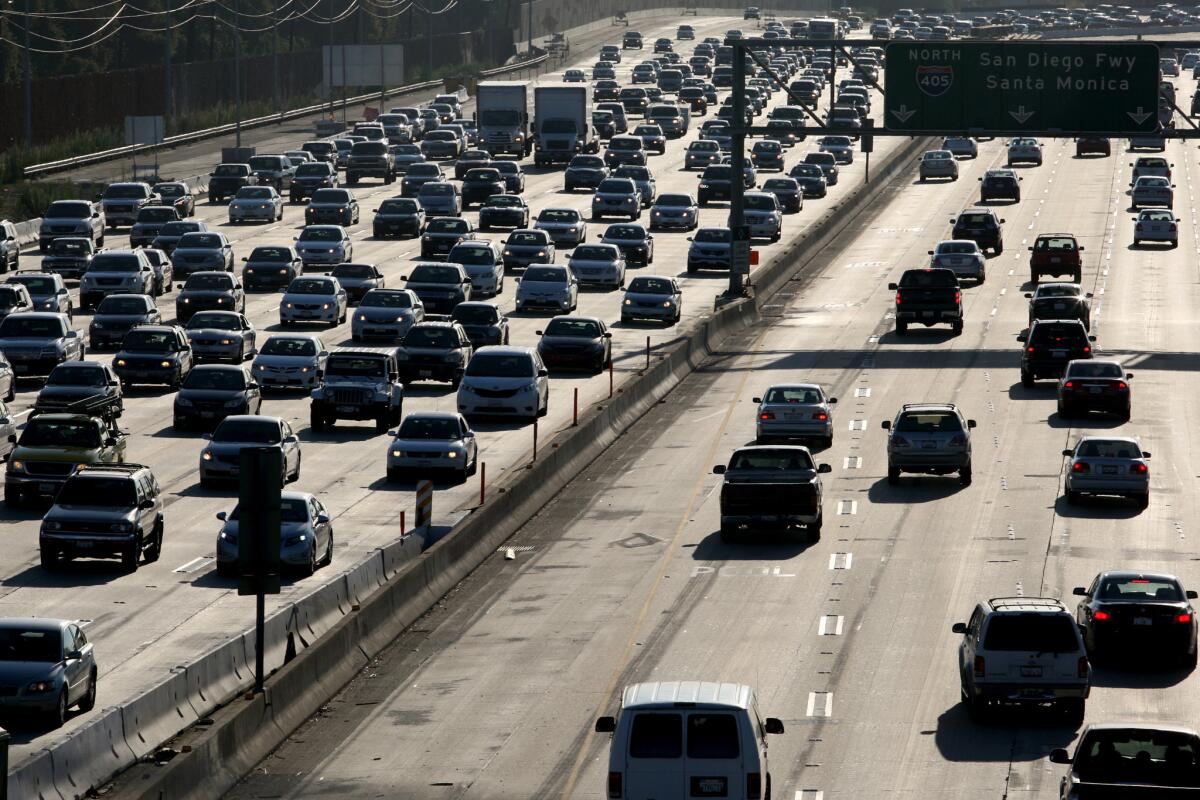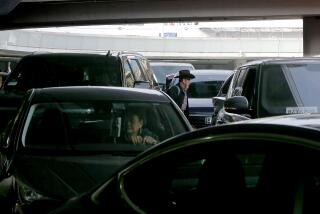Study: One-third of nation’s 30 worst traffic bottlenecks are in Los Angeles area

Traffic crawls along the 405 Freeway near the 22 and 605 freeways in Seal Beach, ranked by a recent study as the second-worst bottleneck in the United States.
Every Southern California commuter who has stared through the windshield at stop-and-go traffic can name at least one portion of a freeway that makes rush-hour driving particularly painful.
Mostly, they’re the usual suspects: the 405 Freeway through the Sepulveda Pass, the 5 Freeway through Commerce, the 101 Freeway through the San Fernando Valley.
But a less common way to analyze which bottlenecks are the worst has turned up a few surprises.
A study released Monday by the American Highway Users Alliance, a nonprofit group that lobbies for interstate highway investment, examined which routes in the United States are the most continuously crowded, 24 hours a day, rather than during peak periods. Eleven of the 30 worst bottlenecks are in Greater Los Angeles.
“These are corridors that are continually congested,” said Monali Shah, the director of intelligent transportation at Here Connected Driving, one of the companies that provided GPS speeds for the study.
According to the researchers, the worst Southern California freeway bottlenecks — and their national rankings— are:
- No. 2: The 405 between the 22 and 605 in Seal Beach
- No. 3: The 10 between Santa Fe Avenue and Crenshaw Boulevard
- No. 4: The 405 between Venice and Wilshire boulevards
- No. 5: The 101 between Franklin Avenue and Glendale Boulevard
- No. 6: The 110 between Exposition Boulevard and Stadium Way
- No. 7: The 101 between Sepulveda and Laurel Canyon boulevards
- No. 11: The interchange between the 5 and 110 between the 101 and North Mission Road
- No. 13: The 10 between La Brea Avenue and National Boulevard
- No. 14: The 5 between South Eastern and Euclid avenues
- No. 29: The 405 between Burbank and Ventura boulevards
- No. 30: The 101 between the 110 and Alameda Street
Using traffic speed data for passenger and freight vehicles and average traffic volumes along major corridors, researchers ranked the bottlenecks based on average estimated delays daily.
The 11 jams represent about 44 million hours of lost time, or about half of the daily total delays on the list of the 30 worst bottlenecks, the study said. Southern California commuters lose nearly $1.17 billion in lost time on the routes.
The worst bottleneck in the country is in Chicago, along the Kennedy Expressway, the freeway that connects downtown with the city’s north and northwest suburbs, the study found. The stretch of Interstate 90 between Interstates 290 and 94 generates 17 million hours — or nearly 1,940 years — of delay annually.
The findings, Shah said, can help inform local governments about when and how to invest in expanding freeway capacity. That idea has become controversial in recent years, as commuters in some U.S. cities have seen little relief after years-long, multimillion-dollar freeway expansions.
NEWSLETTER: Get the day’s top headlines from Times Editor Davan Maharaj >>
A study from the traffic data company Inrix showed that travel times did not improve after the 405 Freeway was widened through the Sepulveda Pass. The addition of a carpool lane cost more than $1 billion and took four years.
“There’s a limit to how much the road network can be expanded,” Shah said. In those cases, she said, technology — including gauging real-time road conditions — will come into play.
In the last two years, more than 2 million Los Angeles-area commuters have turned to the traffic app Waze to find alternate routes to crowded freeways.
For more transportation news, follow @laura_nelson on Twitter.
Hoy: Léa esta historia en español
ALSO
El Niño may trigger floods, famine and sickness in much of the world
Who is L.A.’s infamous ‘teardrop’ rapist? And when will he be caught?
Holiday travelers be warned: Huge snowstorm coming to Sierra Nevada
More to Read
Start your day right
Sign up for Essential California for news, features and recommendations from the L.A. Times and beyond in your inbox six days a week.
You may occasionally receive promotional content from the Los Angeles Times.







